The Samsung Galaxy Note 4 Review
by Joshua Ho on October 15, 2014 9:00 AM EST- Posted in
- Smartphones
- Samsung
- Android
- Mobile
- Galaxy Note 4
Battery Life
Battery life is one of the most important aspects of any mobile device, especially because the battery is what defines mobility to begin with. As a result, it’s important to test battery life in a meaningful manner. This requires a repeatable test with standardized conditions, and a range of scenarios that stress different aspects to get the full picture. Most importantly, for tests that have the display on we calibrate the display to 200 nits to ensure that the test doesn’t penalize brighter displays. In the case of the Galaxy Note 4, we see about a 3% gain in battery capacity, so most of the battery life gains should come from higher efficiency.
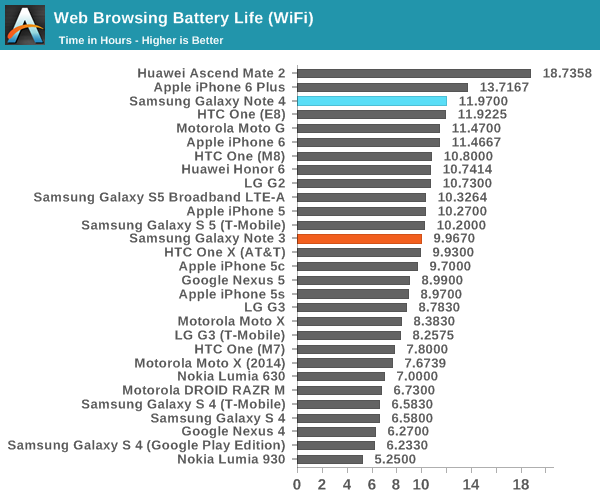
Our first test is the WiFi web browsing test, which loads a given set of web pages in a loop, with special emphasis taken in order to ensure that the test doesn’t penalize faster SoCs, which would have significant effects on our results. As one can see above, the Galaxy Note 4 has a noticeable uplift in battery life when compared to the Galaxy S5 and lasts significantly longer than the Galaxy Note 3. It doesn’t last quite as long as the iPhone 6 Plus, but few people should have issues getting through a full day of intensive use.
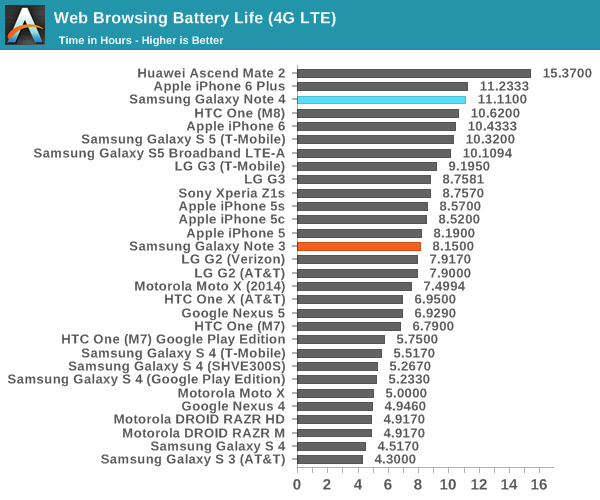
On LTE web browsing, a similar story plays out as the Galaxy Note 4 is able to keep up with the competition and delivers the massive improvement that we’ve generally seen from the transition to Snapdragon 801 and 805.
While the web tests are well-worn by now, we’ve added two additional tests to the battery life suite in order to get a better picture of SoC-bound battery life. To this end, we use an infinite loop of T-Rex on-screen to replicate a GPU-intensive scenario and Basemark OS II’s battery life test to simulate a CPU-intensive scenario.
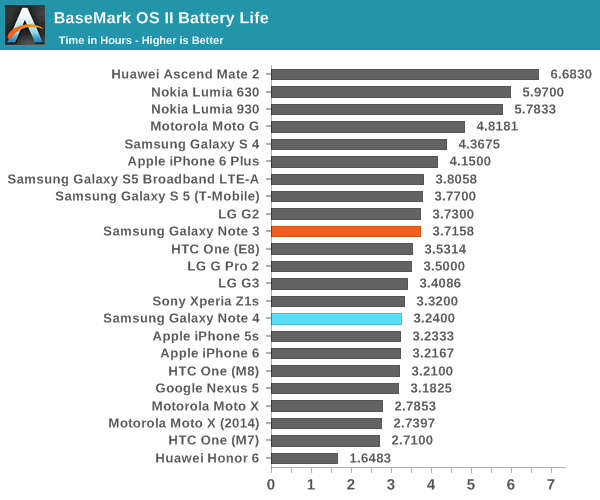
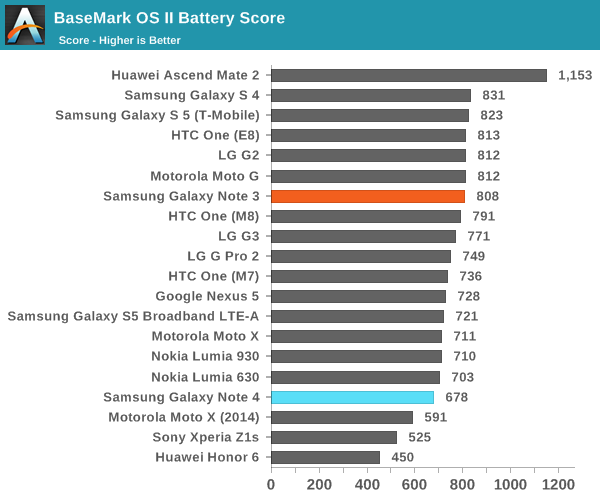
In the case of the Basemark OS II test, we see that battery life under a sustained task ends up a bit lower than we expect, which seems to suggest that in CPU-bound tasks the Note 4 doesn't have much better efficiency when compared to the Galaxy Note 3. This seems to be self-evident, as the CPUs are quite similar and the process technology used is largely similar when comparing the two devices.
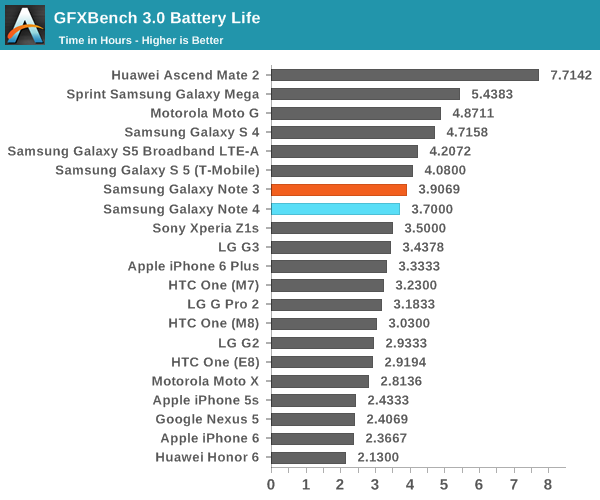
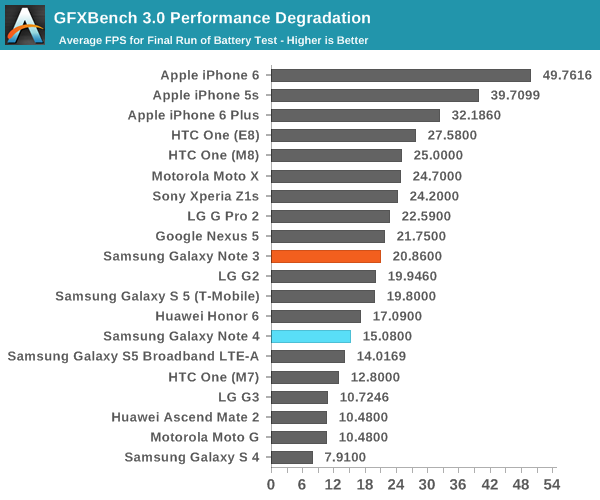
In GFXBench's endless rundown test we see that the Galaxy Note 4 trails behind in battery life when compared to the GS5 LTE-A, but looking at the end of run FPS it’s quite clear that the Galaxy Note 4’s larger surface area makes it possible to achieve greater performance.
Overall, battery life is quite good on the Galaxy Note 4. It’s a massive leap forward when compared to the Galaxy Note 3, but a relatively small one when compared to the Galaxy S5. Once again, we see that most of the benefits in battery life will come from scenarios where power draw isn’t strongly influenced by the display.
Charge Time
As a part of the overall battery life story, it's important to consider the time it takes for a battery to fully charge. If a phone's battery charges slowly then scenarios where charge time becomes crucial will severely hurt real-world battery life. For example, if one forgets to charge their phone at night, the rate at which the phone will charge the battery is a strong influence upon actual battery life. In order to test this, we measure power draw from the time that the device under test is plugged in until it reaches a given level of power draw that indicates that the battery is fully charged.
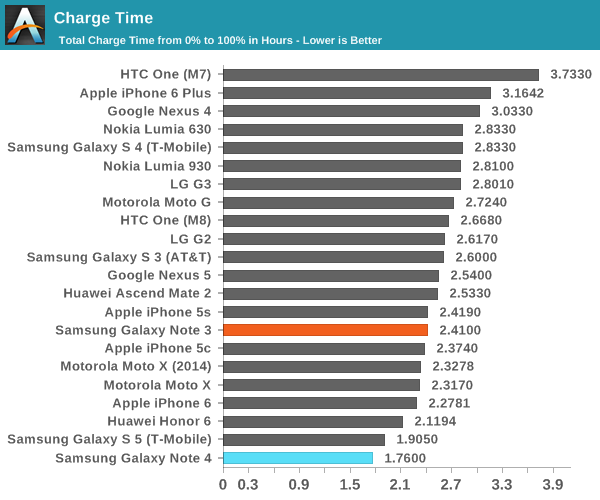
As one can see in the graph above, the adaptive fast-charge mechanism really works, although I don't see a huge benefit when compared to the Galaxy S5's charge time which was already incredibly fast. In the case of the Galaxy Note 4 it seems that it switches between a 9V, 1.64A mode and a 5V, 2A mode as needed, and most of the benefit would come from the first 50% or so of charging as power drops rapidly as the battery approaches full charge.










195 Comments
View All Comments
Donkey2008 - Wednesday, October 29, 2014 - link
You have to love the 3DMark "onscreen" vs "offscreen" results. As long as any Android doesn't have to actually render images on the screen for the user than it is just as fast as an iPhone. ROLMAO.Announcer97624 - Saturday, November 1, 2014 - link
I don't get the point about battery life trailing behind the IPhone 6 plus? The IPhone 6 plus doesn't have a removable battery so on a 16 hour plane ride the IPhone 6 plus is a liability not an asset compared to the Galaxy Note 4's ability to have a few spare charged batteries. While I have the European Galaxy S5 4G LTE I have a battery wallet with six fresh batteries so I can go for most of a week without charging. My girlfriend has an IPhone 5 and is now going to purchase the Galaxy Note 4 specifically because of the non removable battery on all IPhones.Bikerboy89 - Saturday, November 8, 2014 - link
Wow onscreen GPU performance is laughable. Really bad vs the competition from apple and Nvidia. My LG G Flex gets better onscreen performance in gfxbench and the iPhone 6 gets double or triple Note 4. Pretty pathetic for a flagship device.MattL - Wednesday, November 19, 2014 - link
I finally realize why your color accuracy results differ so much from display mate, where you find the iPhone is more color accurate they found the Note 4 more accurate.http://www.displaymate.com/news.html#Color_Accurac...
"Recently some reviewers have published articles contradicting my Absolute Color Accuracy Measurements for the Samsung Galaxy S5. For example, see this recent review in phone Arena. The problem is that these reviewers are not scientists or display experts, and are using canned display calibration software incorrectly in order to test a display, which produces incorrect results and bogus conclusions. Below is a brief semi-technical analysis...
The Color Difference dE used by the Reviewers Incorrectly includes the Luminance: The reviewers are using retail display calibration software products that use a Color Difference measure called dE, which includes a Luminance (Brightness) Error component in addition to the Color Hue and Saturation (Chromaticity) Error component. Using the Color Difference dE is appropriate for setting the display calibration, but dE is Not a measure of Visual Color Accuracy (Hue and Saturation) because it also includes the Luminance (Brightness). The eye sees and interprets brightness and color as two separate visual issues - dE combines them together. So all conclusions based on using dE for Visual Color Accuracy are incorrect.
Our Color Accuracy only includes Color Hue and Saturation: Since the eye sees color and brightness as two separate visual issues I measure and analyze them separately. My published Absolute Color Accuracy measurements and data analysis includes only the Color (Hue and Saturation) Chromaticity Error component Δ(u'v') or d(u'v'), which evaluates just the difference in Hue and Saturation seen by the eye, and is plotted on a 1976 CIE Uniform Chromaticity Color Diagram in all of my articles. This is the correct method for evaluating Visual Color Accuracy (Hue and Saturation). Compare my very precise and detailed Absolute Color Accuracy plots with their crude figure."
Basically you're doing it wrong anandtech
kamhagh - Monday, May 25, 2015 - link
this phone lags on ui and on games like deadtrigger2, don't trust benchmarks! specially when its samsung..... benchamrks are only meaningless numbers!(well useful in some cases)